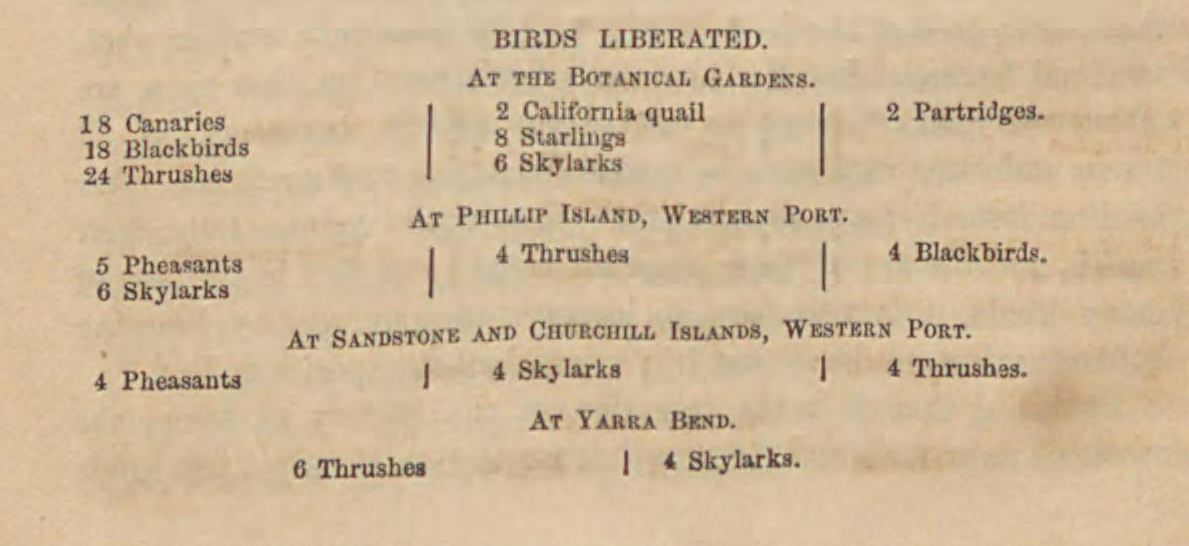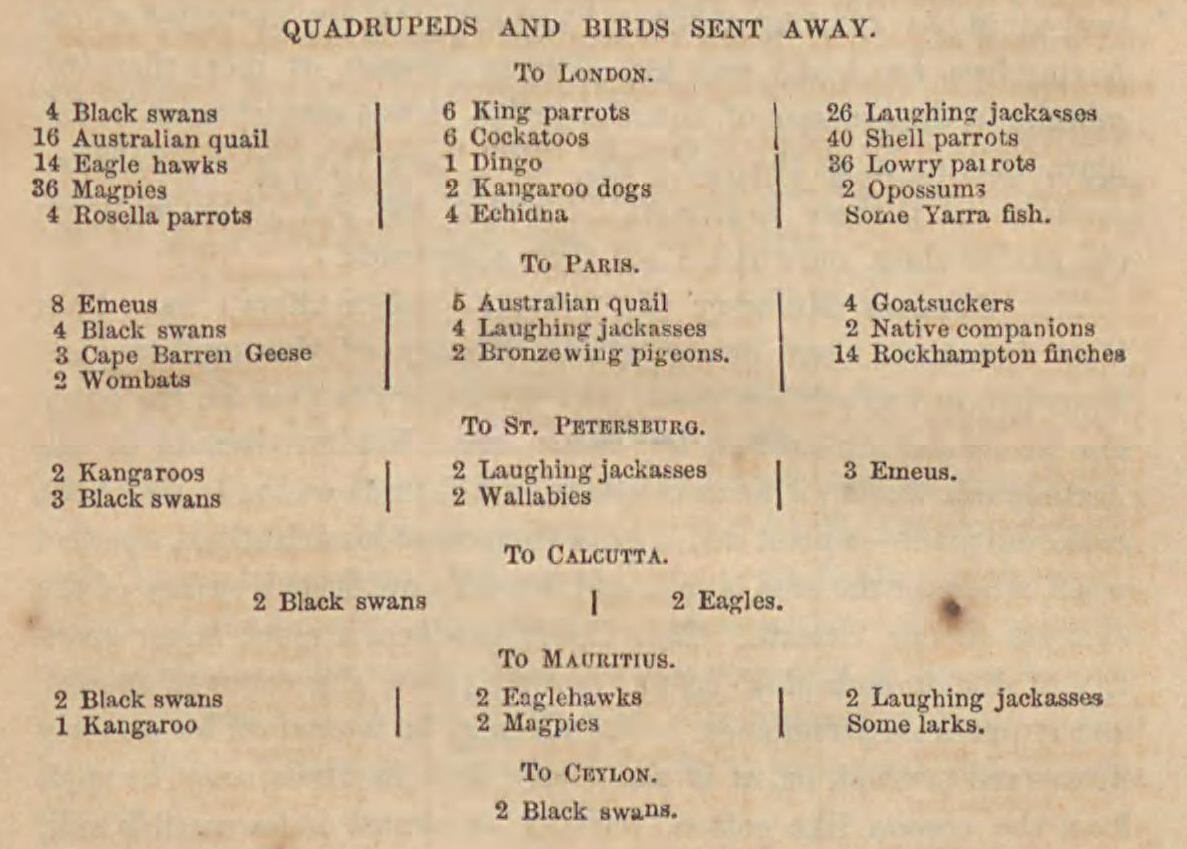“If it Lives, We Want It.” Exploring the Acclimatisation Society of Victoria’s Role in Australia’s Ecological History
The Acclimatisation Society of Victoria played a fascinating, yet devastating, role in Australia’s ecological history. Founded in 1861 and existing as an independent entity until 1872, the Society recorded its objectives and activities in annual reports. These reports have been digitized by Museums Victoria and are now available on the Biodiversity Heritage Library.
 |
| The First Annual report of the Acclimatisation Society of Victoria, 1862. Contributed to BHL by Museums Victoria. http://s.si.edu/2BpCcfK. |
The Acclimatisation Society was established in Victoria’s capital of Melbourne at a time when the city was experiencing great economic and population growth. Gold had been discovered in the colony in 1851 and over the next 10 years the population grew from 76,000 to 540,000. The wealthy and educated flocked to Melbourne, and the 1850s saw the establishment of The University of Melbourne, the National Museum of Victoria, the State Library of Victoria and many learned societies.
The Acclimatisation Society was governed by the colony’s most eminent scientists who believed that Australia’s plants and animals were greatly inferior to those in Europe. The Society’s first president Edward Wilson argued that animals indigenous to Australia were practically useless, providing only ‘a little sport and an occasional meal’ (Gillbank, 1984).
At the Society’s inaugural annual meeting, members were roused with talk of “wharves laden with the fleeces of the alpaca…, rivers teeming with all sorts of fish, forests abounding with every variety of game, and our tables groaning with all the delicacies which can be procured in the markets of London and Paris” (Acclimatisation Society of Victoria, 1862b).
There was great nostalgia amongst the colony for the “delightful reminders of [their] early home”. Frederick McCoy, foundation Professor of Natural Science at The University of Melbourne and first director of the National Museum, proclaimed that “English thrushes, blackbirds, larks, starlings, and canaries” when “liberated” would enliven the “savage silence, or worse” with their “varied, touching, joyous, strains of Heaven-taught melody” (McCoy 1862).
 |
| Birds liberated, from The First Annual report of the Acclimatisation Society of Victoria, 1862. Contributed to BHL by Museums Victoria. http://s.si.edu/2DEkbzh. |
The Society’s objectives were twofold: to introduce to Victoria and acclimatise “all innoxious animals, birds, fishes, insects, and vegetables, whether useful or ornamental” and to spread indigenous plants and animals from the colony to other parts of the world. President Wilson’s motto was “if it lives, we want it” (Tout-Smith, 2018).
Theirs was an enormous undertaking: “to establish a system of co-operation and exchange, with persons residing at different points in the far quarters of the globe, and to arrange for the reception, multiplication, and distribution of birds and other animals, which must first of all bear a tedious sea voyage, and then receive the vigilant attention necessary to preserve them in a new climate” (Acclimatisation Society of Victoria, 1862a).
The Annual Reports outline some significant successes (not all of which were their own doing): “the hare and rabbit have been introduced, and the latter so thoroughly acclimatised, that it swarms in hundreds in some localities” (Acclimatisation Society of Victoria, 1862c).
The Reports not only provide a timeline of species released in Victoria; they also list the species sent elsewhere: echidnas to London, wombats to Paris, kangaroos to Mauritius and possums to New Zealand (an acclimatisation “success” that New Zealand may never forgive).
 |
| Quadrupeds and birds sent away, from The First Annual report of the Acclimatisation Society of Victoria, 1862. Contributed to BHL by Museums Victoria. http://s.si.edu/2n4u9kb. |
However, most of their expensive acclimatisation experiments failed. In the early 1870s, The Acclimatisation Society began to focus on the importation of exotic animals for display purposes and in 1872 it was renamed The Zoological and Acclimatisation Society of Victoria. Their Annual Reports (also available on BHL) provide an equally fascinating history of what would become The Melbourne Zoo, but that’s another story.
 |
| Crustacea, from The First Annual report of the Acclimatisation Society of Victoria, 1862. Contributed to BHL by Museums Victoria. http://s.si.edu/2n90R33. |
Today Australia’s introduced species cause immense environmental and economic damage and have caused more extinctions of native Australian animals than any other factor. The Acclimatisation Society of Victoria, however, was certainly not to blame for all this devastation. While their lists of “liberated” animals include many of our most destructive invasives, they are generally only credited with the introduction of starlings, sparrows, sambar deer and European carp (Tout-Smith, 2003).
The legacy they expected to leave behind is very different from the one presented here, as evidenced by McCoy’s statement in his anniversary address delivered at the Society’s first annual meeting:
…the good we do will live after us, and the work of our hands will thrive and prosper to our hearts’ content, and so become a lasting benefit to the millions of men who will in the fullness of time inhabit this land. (McCoy, 1862)
References
- Acclimatisation Society of Victoria, 1862a. Annual report of the Acclimatisation Society of Victoria. No. 1.
- Acclimatisation Society of Victoria, 1862b, Proceedings of the Annual General Meeting, 24 November 1862, Annual report of the Acclimatisation Society of Victoria. No. 1.
- Acclimatisation Society of Victoria, 1862c. Annual report of the Acclimatisation Society of Victoria. No. 1.
- Gillbank, L. 1984. The Origins of the Acclimatisation Society of Victoria: Practical Science in the Wake of the Gold Rush. Historical Records of Australian Science 6, 359-374. https://doi.org/10.1071/HR9860630359.
- McCoy, 1862. Anniversary address delivered at the first annual meeting of the Acclimatisation Society of Victoria. In Annual report of the Acclimatisation Society of Victoria. No. 1.
- Tout-Smith, D. 2003. Acclimatization Society of Victoria in Museums Victoria Collections. https://collections.museumvictoria.com.au/articles/1803. Accessed 18 January 2018.





Leave a Comment